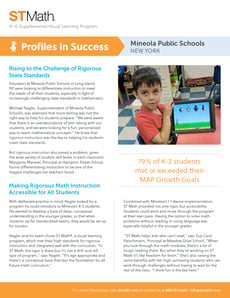District Facts
District Grade Levels: K-12
District Enrollment: 2,695
District Type: Large, public, suburban
Number of Schools: 5
District Enrollment: 2,695
District Type: Large, public, suburban
Number of Schools: 5
Demographic Breakdown
Caucasian: 58%
Hispanic: 26%
Asian: 12%
African American: 3%
Other: 1%
FRL: 26%
EL: 11%
Hispanic: 26%
Asian: 12%
African American: 3%
Other: 1%
FRL: 26%
EL: 11%
ST Math Implementation
Grades using ST Math: K-2
Type of ST Math instruction: Classroom
Type of ST Math instruction: Classroom
Rising to the challenge of rigorous state standards
Educators at Mineola Public Schools in Long Island, NY were looking to differentiate instruction to meet the needs of all their students, especially in light of increasingly challenging state standards in mathematics.
Michael Nagler, Superintendent of Mineola Public Schools, was adamant that more testing was not the right way to help his students prepare. “We were aware that there is an overabundance of test-taking with our students, and we were looking for a fun, personalized way to teach mathematical concepts.” He knew that rigorous instruction was the key to helping his students meet state standards.
But rigorous instruction also posed a problem, given the wide variety of student skill levels in each classroom. Margarita Maravel, Principal at Hampton Street School, found differentiating instruction to be one of the biggest challenges her teachers faced.
Keep Reading...
Making rigorous math instruction accessible for all
With deliberate practice in mind, Nagler looked for a program he could introduce to Mineola’s K-2 students. He wanted to develop a base of deep, conceptual understanding in the younger grades, so that when students sat for standardized exams, they would be set up for success.
Nagler and his team chose ST Math®, a visual learning program, which met their high standards for rigorous instruction and integrated well with the curriculum. “In ST Math, the rigor is there but it’s not a drill-and-kill type of program,” says Nagler, “It’s age appropriate and there’s a conceptual base that lays the foundation for all future math curriculum.”
"In ST Math, the rigor is there but it’s not a drill-and-kill type of program. It’s age appropriate and there’s a conceptual base that lays the foundation for all future math curriculum."
Combined with Mineloa’s 1:1 device implementation, ST Math provided not only rigor, but accessibility. Students could work and move through the program at their own pace. Having the option to solve math problems without reading or using language was especially helpful in the younger grades.
“ST Math helps kids who can’t read,” says Sue Caryl Fleischmann, Principal at Meadow Drive School, “When you look through the math modules, there’s a lot of tough reading there. But when they’re working on ST Math it’s like freedom for them.” She’s also seeing the same benefits with her high-achieving students who can work through challenges without having to wait for the rest of the class. “I think fun is the key here.”
Keep Reading...At Hampton Street School and Meadow Drive School


*NWEA’s MAP Growth assessment measures student performance at the start and end of the year by setting personalized goals for each student
Increasing math engagement and achievement
Mineola educators have seen their students take huge strides with the addition of ST Math to their classrooms. Students are no longer just learning a method to solve a math problem, they’re discovering why it works.
When analyzing Hampton Street’s NWEA scores, Maravel noticed a huge jump in critical thinking. “We feel the difference is in ST Math,” she says, “It automatically makes each child think because there are no directions and they have to figure out how to solve a problem on their own. We attribute increased critical thinking to that.”
Trying to figure the clues that JiJi is giving us .. Sometimes ST Math tries to trick us but we are not giving up today ! @Hampton_Street #mineolaproud #STMath #GrowthMindset pic.twitter.com/BMkboYkQnD
— Liz Block (@blockparty_200) December 6, 2017
Hampton Street and Meadow Drive both saw excellent results in their NWEA’s MAP Growth Assessment following one year of ST Math implementation. Seventy-nine percent of their K-2 students met or exceeded their growth goals at the end of the year. Narrowed down to just kindergarteners, the numbers are even more impressive at 92%.
Maravel is seeing ST Math impact spill onto other subjects. “When students walk through a problem, they’re using the kind of thinking that has to occur in other areas throughout the day. No matter the subject, they’re not giving up easily,” she says.
She also points out something else that’s new to Hampton Street: “Teachers often look at the screen when a student is having trouble with ST Math, but often it’s difficult to just jump in, so then they defer to another child. It’s not only the teacher teaching, but children are teaching one another. It’s so motivating.”

